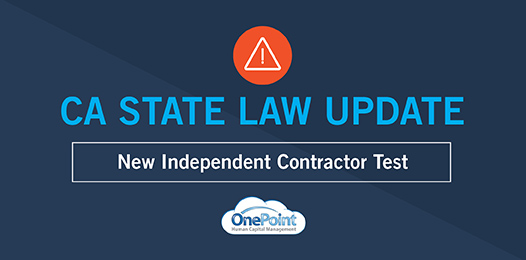California Passes New Independent Contractor Classification

California employers face tougher legal standard for Independent contractor classification
The California Supreme Court has adopted a new, tougher legal standard for determining whether a worker is an independent contractor or an employee. Previously, the state followed a multi-factor balancing test that looked at the level of control held by the employer as well as several economic factors, such as who provided the tools to do the job. The new test, called the ABC Test, is an all-or-nothing test. To properly classify a worker as an independent contractor, the employer must be able to say “yes, this is true” to all three parts of the test.
The ABC Test
A worker may be classified as an independent contractor if:
A. The worker is free from the control and direction of the hirer in connection with the performance of the work, both under the contract for the performance of such work and in fact;
B. The worker performs work that is outside the usual course of the hiring entity’s business; and
C. The worker is customarily engaged in an independently established trade, occupation, or business of the same nature as the work performed for the hiring entity.
A Explained – Free From Control
Every state and federal test currently in use for independent contractors looks at control. Most, however, ask about degree of control. The ABC test is much more definitive—it demands that the worker be free from control. This ruling is only days old, and there will no doubt be litigation about the exact meaning of “free” in the future, but for now we encourage employers to take this criterion at face value. If an employer dictates how or where the work gets done or who does it, they have an employee. Likewise, although an employer may put a “when” on work by establishing a deadline, they should not dictate that the work be done on certain days or during certain hours.
B Explained – Outside Usual Course of Business
An independent contractor must be doing work that is outside the employer’s usual course of business—that is, not essential to the offerings of the business. For example, in a restaurant, the cooks and servers do work that is in the usual course of business, whereas someone hired to design the new menu or reupholster the booths does not. The cooks and servers must always be employees, while those who do work that is not part of the business’s core offering would pass this requirement of the test.
C Explained – Worker Has an Established Business
Part C asks whether the worker is in business for themselves doing the kind of work that they are doing for the organization that has hired them. For instance, does the individual hired to design the new menu offer their graphic design skills on the open market? Do they have other paying customers, a business card, a website, their own graphic design software? Is their business registered with the state?
The focus—in inquiries from the state and in future litigation—will likely be more on whether the individual made money from other sources doing the same kind of work they offered to the employer and less on whether they had the standard business accessories. That said, the more evidence of an established business, the stronger the argument for an independent contractor.
Action Items
Audit Your Independent Contractor Classifications
Because this new standard is case law—meaning it was created by the Supreme Court rather than the legislature—it takes effect immediately. Employers can limit their liability if they analyze their independent contractor classifications and make necessary changes promptly.
Employers who currently use independent contractors should reevaluate each of those relationships and ensure that the worker passes the ABC Test. If they do not, the employer has three options:
- Reclassify the worker as an employee.
- Terminate the worker’s services.
If the relationship passes Part B and C, and only fails on Part A, the employer may be able to alter the parameters of the relationship so that the worker is now free from their control.
Subscribe to updates
Get the latest posts delivered to your inbox.